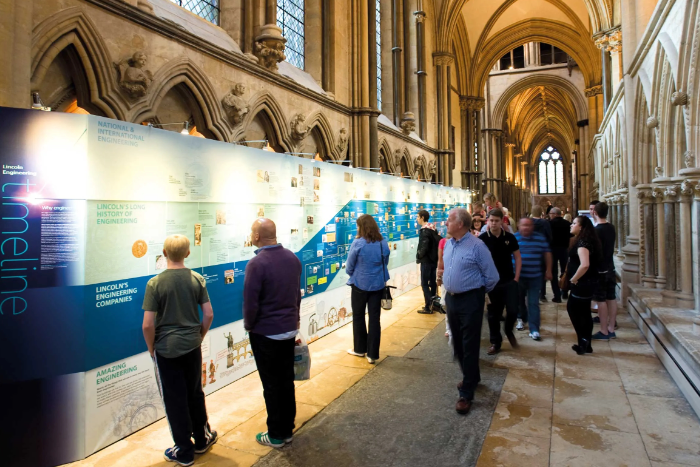
‘He’s gone to the foundry’
Derek Broughton of the Survey of Lincoln recalls working in one of the city’s major engineering firms in the 20th Century.
‘He’s gone to the foundry’ was a regular saying in Lincoln for many years, when the city’s name was synonymous with engineering.
The works of companies such as Ruston and Hornsby; Robey’s; Clayton Dewandre; Foster Gwynnes; Ruston Bucyrus; Clarkes Crank; and Penny and Porter, all in business at some stage during the middle years of the twentieth century from the 1930s to the 1960s, were known generically as ‘the foundry’.
Engineering was by far Lincoln’s major employer. In the late 1950s and early 1960s, it is estimated that Ruston Bucyrus was the workplace of some 3000 employees; and Ruston and Hornsby and Clayton Dewandre each employed over 2000 workers. Several excellent histories have been written of some of the major companies. However, what was it really like to ‘go to the foundry’?
My grandfather worked for Ruston’s for fifty years and he travelled all over the world in the days of steam ships. His tales of building engines in faraway places; the wonderful illustrations of all things mechanical in the centre pages of The Eagle comic; and the intricacies of Meccano meant in my own instance that, although passing my eleven plus at Westgate School and G.C.Es at what was then the Grammar School on Wragby Road, I decided higher academia was not for me and, in the autumn of 1959, one solitary grammar-school boy joined about 30 secondary-school boys at Ruston’s ironworks as a five-year craft apprentice.
Much of my apprenticeship involved locomotive- and engine-building at the Boultham Works, plus time at the firm’s Anchor Street premises in the new age of gas turbines. Perhaps the most fulfilling time of all was spent on the large engine test in 64 Workshop at the Ironworks and the Research Centre on Beevor Street.
Although demolished in c.2005, in the 1950s and 1960s it was probably one of the best diesel engine test facilities in the world. Even after the takeover of Ruston’s by English Electric in 1970, much of the larger company’s engine range development took place in Lincoln.
Entering the foundry was an eye opener, a life-changing experience. It was an assault on the senses, a culture shock. I was brought up a Methodist and one of the first learning experiences that appeared to be offered (unofficially) was a crash course in what would probably be best described as vernacular Anglo-Saxon.
In the ironworks apprentice ‘shop’, experienced hands tried to break your soul and acclimatised you to the rough and tumble of factory life. Here apprentices developed confidence in handling tools, and acquired specific skills such as in using a radial drill (capable of drilling two-inch holes through a boiler plate) drilling a hole only 1/16th inch in diameter without breaking the drill bit. After this initiation apprentices were finally let loose through various postings in each factory site to give them a rounded and comprehensive experience, competence, and knowledge, whilst all the time monitoring their progress to evaluate if they would be worth keeping on after five years, and, if so, in what capacity.
The size of the Lincoln engineering workplaces was impressive. During the 1950s and 1960s the 30-ton shunting locomotives made at Boultham Works were capable of pulling over 1000 tons. The 16 ATC engine at the Research Centre was the size of a furniture van and capable of producing almost the combined horsepower of 100 Minis. Workers needed a ten-foot stepladder to reach the valve machinery. Walking into 22-bay at RB workers would see 60-plus tons of 71 RB machine sailing overhead down the bay powered by the overhead cranes. Walking over to the test ground at RB, visitors could see one of the supercranes on test lifting 120 tons. It was said that with a lighter load and longer jib if you placed a similar machine in one goalmouth at Sincil Bank, the hook would hang in the centre circle.
Unless having actually stood on the top deck of a 16 AT engine running flat out, it is impossible to conceive of the sheer intensity and complexity of the noise. This included the clatter of sixteen sets of valve machinery; the deep rumble of sixteen pistons, each the size of a small dustbin, all rotating over 400 times a minute in what was effectively a big tin box; and the scream of hundreds of cubic feet of air per minute rushing through twin turbos. Unsurprisingly, perhaps, most communication near to the machinery took place using a form of sign language. Employees were provided with basic ear protection, but this comprised merely cheap boxfuls of disposable soft-rubber ear plugs.
Each area of the foundry had its own distinctive and pervasive smell: the dry, acrid aroma of the electric-arc welders; the choking, rusty dust of the fettling shop that you could almost taste; the warm, almost antiseptic smell of the coolant fluid in the machine shops; the invasive smell of diesel fuel in the test areas that would need sometimes more than one hot bath to remove; and even worse, the tarry smell of the sticky heavy-fuel oil used on some of the larger engines so thick it had to be heated to make it flow, and guaranteed to rot the soles off shoes in a very short time.
Many would suggest that working at the foundry was like being in a ‘family’ and often it was, but every family has its ups and downs, and for every up (and I am sure that everyone who worked in that environment would have some good or even hilarious story to tell), it has to be said that there were the downs such as injuries and even occasional fatalities. Perhaps the most regular low point associated with foundry life in the 1970s and 1980s was the long and dreary catalogue of redundancies associated with the protracted decline and death of the big names and their factories.
How would I sum it up? I think I would borrow the title of Henry Brown’s Lincolnshire autobiography ‘Them days is gone’. Gone, yes, but not forgotten.
- A more detailed account of Derek’s time at the foundry can be found in The Survey of Lincoln’s Boultham and Swallowbeck volume in its neighbourhood series. Derek has also written about Ruston Bucyrus in The Survey’s latest volume, Lincoln’s Engineering Industries: A Concise History, c.1780-1980s which is on sale in several Lincoln bookshops from early December.
Find out more about The Survey’s work at www.thesurveyoflincoln.co.uk.
Picture shows visitors to the regular Spark exhibition studying Lincoln’s historic engineering timeline. Picture: Optima Design.
